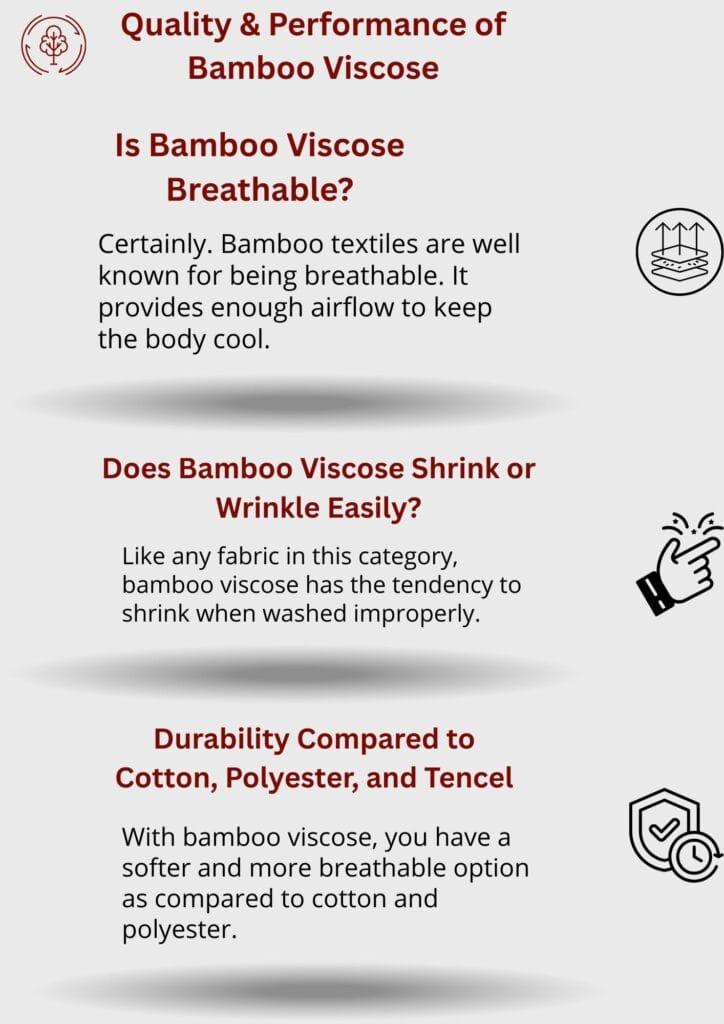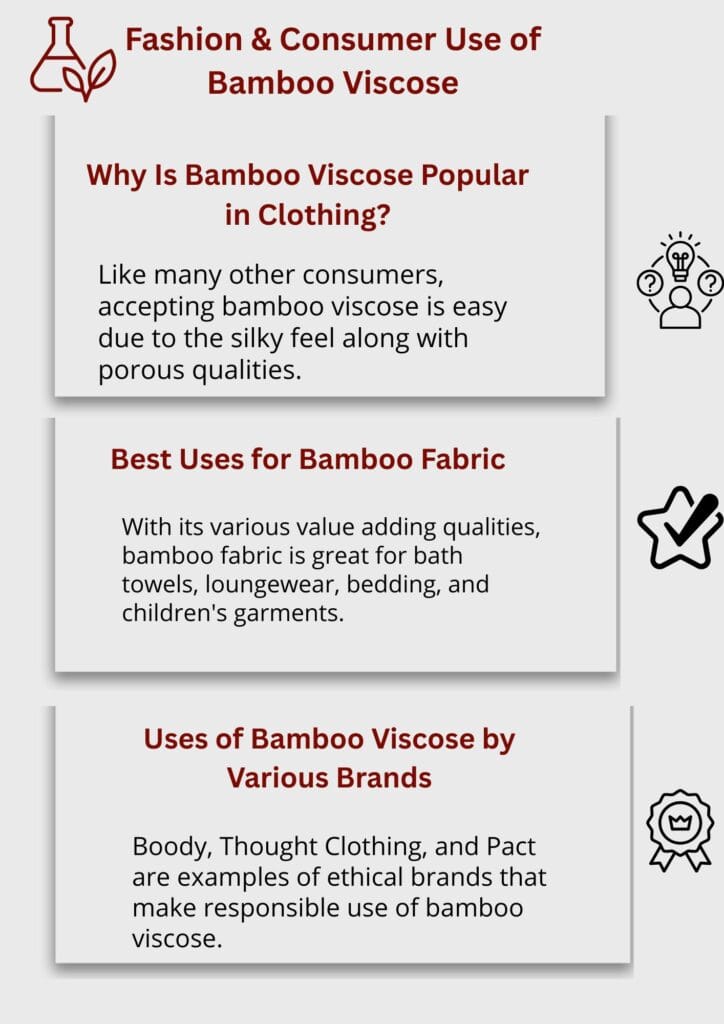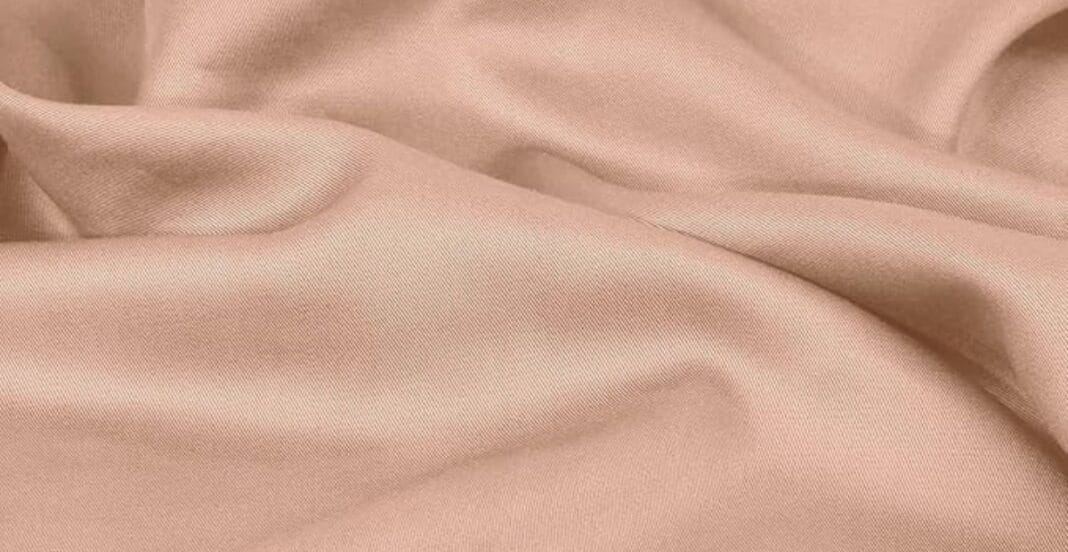Introduction
Bamboo plants are often considered a miracle biomass for sustainable fashion due to fast growth, quick regeneration, and no need for pesticides. The narrative, however, changes for bamboo fabric, especially bamboo viscose.
Myths regarding bamboo viscose will be addressed, shedding light on its eco advantages and guiding you on becoming a responsible buyer.
Is Viscose Bamboo? The Inquiry of Relation
Frequently, customers are inundated with the question of whether fabrics’ viscose form is indeed bamboo. And, just like many brands claim, the answer is not simple at all. Yes, does come from bamboo. Nonetheless, it is notconsidered a natural fiber at the final product stage.
Bamboo Fabric vs. Bamboo Viscose
Whereas the term fabric’ refers to two mechanized forms, either ‘bamboo linen’ or a chemically processed ‘bamboo viscose.’ The latter being what fills the shelves of clothing stores.
Viscose Bamboo is a poorly processed product which makes it’s usage on clothes alarming. Clothing marked “bamboo” are often made from viscose, which is made using brute force chemical procedures. On the contrary, mechanically processed bamboo fabric is rare, but more eco friendly—and expensive.
Common Myths Surrounding Bamboo Viscose
There is a widespread belief that bamboo fabric is always environmentally sustainable. This misconception arises from the fact that bamboo grows quickly and requires few resources. However, when it is converted to viscose through chemicals, the sustainability of the fabric depends on the nature of the processes involved in its production.
Another common query is, “Is bamboo viscose eco-friendly?” The answer is—it depends. Different processes have varying degrees of sustainability. Without appropriate controls in place, the can give rise to pollution and other social issues stemming from unsafe working environments.
Understanding Viscose from Bamboo
What Is Bamboo Viscose?
Bamboo viscose is a sort of rayon which is produced by transforming cellulose from pulp. It is soft and breathable and is often likened to silk. Although it is categorized as a plant product, it is in reality a synthetic product.
How Bamboo Is Turned into Viscose
The transformation of bamboo into viscose starts with the harvesting of bamboo which is then crushed to form a pulp. Additions of sodium hydroxide along with carbon disulfide serve to breakdown the pulp under certain conditions. The viscous liquid produced is forced through spinnerets which converts it into threads and later solidifies into fibers.
As a result of this processes, the material becomes a semi-synthetic fiber instead of natural. The chemical side poses concerns over the product’s carbon footprint.
Is Bamboo Rayon the Same as Bamboo Viscose?
Bamboo rayon and bamboo viscose are two names for the same product. Each name varies based on which method of production is used. While some brands prefer the name “rayon,” others opt for “viscose.” Regardless, both names denote the exact same chemical structure.
Sustainability & Eco-Friendliness of Bamboo Viscose
Is Bamboo Viscose Sustainable?
Viscose made fromdoes depend upon its processing method. Moreover, bamboo itself is ecologically sustainable. But bamboo viscose raises some controversies. Producing bamboo viscose raises ecological concerns if produced through traditional methods, due to the use of toxic chemicals.
Recycling of Outputs: Viscose vs. Lyocell – Which Is Greener?
As for other types of fibers, bamboo lyocell utilizes safer solvents such as N-Methylmorpholine N-oxide, NMMO, which is more efficient, recycling 99% of wasteful materials branding products by these manufacturers much more environmentally friendly. Therefore, bamboo lyocell’s products become truly eco-friendly perspectives. Thus, if your choice is among lyocell or traditional bamboo viscose, lyocell would be the more sustainable option.
Bamboo Viscose vs Organic Cotton – Which Is Better?
Organic cotton has distinct environmental benefits since it does not use pesticides, though it requires more land and water than bamboo. Bamboo, on the other hand, grows much faster and uses less water. But its processing into viscose is quite chemical intensive.
If you want the benefits of both, look for organic lyocell or certified bamboo viscose.
The Biodegradability of Bamboo Viscose
Though undergoing chemical treatment, bamboo viscose is still biodegradable. It can break down in a matter of months through composting. However, the processing methods and local waste management systems will greatly determine how environmentally friendly it is at the end of its lifecycle.
Quality & Performance of Bamboo Viscose

Is Bamboo Viscose Breathable?
Certainly. Bamboo textiles are well known for being breathable. It provides enough airflow to keep the body cool. This is partly why it is preferred in hotter regions and for activewear.
For easy sweaters, it is perfect because of it’s ability to wick moisture and offer natural ventilation.
Does Bamboo Viscose Shrink or Wrinkle Easily?
Like any fabric in this category, bamboo viscose has the tendency to shrink when washed improperly. Maintaining a cold wash and line dry should help. It also wrinkles less than pure cotton and more than synthetic fabrics.
Doing the right things for clothing maintenance preserves the fabric’s life span while looking new.
Durability Compared to Cotton, Polyester, and Tencel
With bamboo viscose, you have a softer and more breathable option as compared to cotton and polyester. However, it is not as durable as polyester, or Tencel. This makes it a good fabrics for daily wear as long as it is well taken care of.
Health & Safety Concerns
Are There Toxic Chemicals in Bamboo Viscose?
The traditional viscose process uses sodium hydroxide and carbon disulfide. These two chemicals pose health risks to workers and the environment, especially when factories lack proper containment or recycling systems.
Nonetheless, harmful residues, if any, are non-existent and safe for consumer use.
Is It Skin Friendly?
It is considered hypoallergenic and soft, making it easier to deal with for sensitive skin. It breathing and minimizes rubbing of the skin especially for parents as it is used for infants.
Does It Cause Allergies or Skin Issues?
While uncommon, mild skin irritation and blockage can occur with the presence of some fabrics and chemical residues. Certification provides a solution through regulated for those concerned. Always look out for OEKO-TEX and other reputable safety marks.
Fashion & Consumer Use of Bamboo Viscose

Why Is Bamboo Viscose Popular in Clothing?
Like many other consumers, accepting is easy due to the silky feel along with porous qualities. As if that is not enough, garments such as leggings and T-shirts are also worn during all seasons as well as odor resistant.
The material is highly valued due to the luxurious texture at a low price.
Best Uses for Bamboo Fabric
With its various value adding qualities, bamboo fabric is great for bath towels, loungewear, bedding, and children’s garments. Comfort driven goods benefit greatly due to the softness and moisture-wicking nature of the products.
Since it is lightweight as well as breathable, it is preferred in eco-friendly active wears.
Uses of Bamboo Viscose by Various Brands
Boody, Thought Clothing, and Pact are examples of ethical brands that make responsible use of bamboo viscose. These brands are known to work with closed-loop systems and certified supply chains. Remember to look up whether a brand is transparent on its bamboo sourcing.
Advertising Deception and Greenwashing
How Brands Mislead with “Eco-Friendly Bamboo”
Countless brands are labeling their clothing “eco-friendly without mentioning the production of viscose. This is bound to mislead audiences since the fabric is not fully organic or natural unless certified.
Most of the time, there is no transparency on these claims, so it’s safe to say such statements are more advertising gimmicks than reality.
What to Look For
To avoid purchasing irresponsibly-made viscose, ensure that the products have the following certifications:
- OEKO-TEX: No harmful chemicals in the product.
- FSC: The bamboo is sourced sustainably.
- GOTS: Applies to some bamboo lyocell and organic blends.
These certifications strengthen the claims that your purchase is safe and environmentally friendly.
Addressing Common Long-Tail Questions: Answered
Is Bamboo Viscose Better Than Cotton?
This is subjective and depends on individual needs. Bamboo viscose has a softer and more breathable texture compared to cotton. On the other hand, organic cotton does have lower chemical concerns but does require more water. Bamboo viscose is gentle on sensitive skin, but cotton is likely to be more durable than viscose fabrics over time.
Does Bamboo Viscose Shrink in The Wash?
Shrinking is possible after washing in hot water and high-heat drying. The best way to avoid this is to wash in cold water and air dry. Always follow the care label guidelines as well.
Is Bamboo Viscose Safe For Babies?
viscose, especially OEKO-TEX certified, is safe for babies. The soft and hypoallergenic nature of the fabric makes it ideal for infant skin. However, ensure that the product does not contain harmful dyes or chemicals.
Why Is Bamboo Viscose So Soft?
The processes used to produce bamboo viscose give it its silky texture. In addition, its moisture-wicking properties and smooth nature keeps the fabric soft and increases the luxurious feel.
How to Care For Bamboo Viscose Fabric?
Follow the garment care label instructions and your viscose will be in good condition.
- Use cold water
- No harsh detergents
- Dry flat or hang dry
- Iron only on low if necessary
If you follow these, the garments will retain their softness, color, and durability for a long time.
Concluding
The former statement suffices: eco-friendly viscose can be manufactured from bamboo. However, the turn-planting process is a whole different story. It differs from one manufacturer to another. While some brands are up to standard and create viscose in an environmentally considerate way, most do not bother to follow regulations.
Having brand transparency has never been as important as it is now. Striving for eco-friendly products and sought after certifications should be a brand’s main priority. When done right, viscose proves great comfort while providing good performance and partially eco-friendly.


